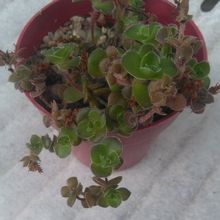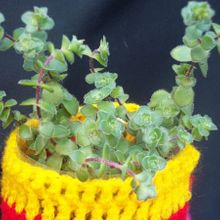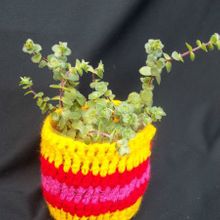





A small but robust perennial succulent herb that produces attractive tiny rosettes of fleshy, oval leaves, usually less than a centimeter in length, which are fringed with small white bristles. It forms very dense cushions or mounds sometimes up to 40 cm wide and 5-10 cm high (25 cm in flower). The crimson buds open into small, white or reddish flowers in summer. The flowers develop into small capsules that release fine seeds in powder form. The entire plant is usually clothed with spreading bristles, but larger leaves are sometimes quite bare.
This species is extremely variable, especially as regards its leaves, which vary in size, shape and hairiness with several different varieties or forms.
Key characteristics:
Stem: Herbaceous more or less woody towards the base, slender, simple or branched from the base (thus appearing many-stemmed), erect, rooted, sometimes pendulous, rigidly hairy, and up to 23 cm tall and erect when flowering (usually shorter, sometimes dwarfed).
Roots: The root system is adventitious.
Rosettes: Very densely packed, minute, greenish-grey, usually no more than 1 inch high and 1-1/2 inch wide, each with about 2-10 pairs of leaves close together. In winter the leaves are stained bronze.
Leaves: Basal leaves in pairs, 4-ranked or densely packed in a rosette. Old leaves left on the stem. Up to 35 mm long and 2 to 10 mm wide, acute to pointed, flattened to more or less convex below but generally flat or ribbed above, green suffused with red, hydathodes present on margins and upper surface, hairy to hysoid on one or both surfaces, and ciliate (or glabrous except on margin). Margins entire, edged with red, minutely bristly to rigidly ciliate. Upper leaves (on flowering stem) sessile, lanceolate, hairy, opposite, reduced upwards.
Flowers: White to pale greenish-yellow inside, grayish-pink outside, with purplish stripes, pendent.
Flowering time: end of November to April in South Africa.
Fruits: Follicles 1.5 to 3.5 mm long (with styles).
Seeds: Fine powder, about 0.5 mm long, subflank-tuberculate.
Temperature: It requires low temperature for flower formation and will not flower unless overwintered for at least a month at 15 degrees Celsius or below.
Fertilization: Fertilizer should be applied only once during the growing season, diluted at the recommended rate on the lab